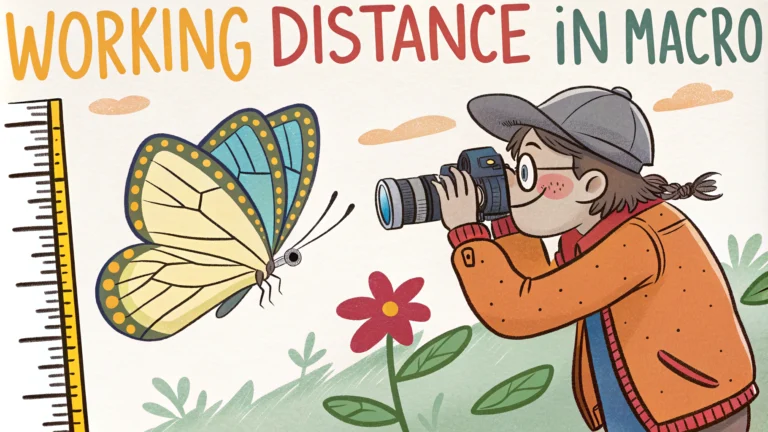Working distance in macro photography refers to the space between your camera’s front lens element and your subject.
A longer working distance gives you more room to set up lighting and prevents casting shadows on your subject.
Why Working Distance Matters
- Prevents disturbing live subjects like insects
- Allows space for lighting equipment
- Reduces lens shadows on the subject
- Provides safer distance from hazardous subjects
Factors Affecting Working Distance
Your lens’s focal length is the main factor determining working distance – longer focal lengths provide more working space.
| Focal Length | Typical Working Distance |
|---|---|
| 50mm macro | 2-3 inches |
| 100mm macro | 6-8 inches |
| 180mm macro | 12-15 inches |
Tips for Managing Working Distance
- Use extension tubes to increase magnification without reducing working distance
- Consider a telephoto macro lens (100mm or longer) for shooting shy subjects
- Add a close-up filter instead of extension tubes to maintain working distance
- Use focusing rails to fine-tune your distance without moving the camera
Recommended Equipment
The Canon MP-E 65mm f/2.8 1-5x Macro offers excellent working distance for extreme magnification.
The Sigma 180mm f/2.8 APO Macro EX DG OS HSM provides generous working distance for shooting timid subjects.
Common Working Distance Issues
- Insufficient space for lighting setup
- Camera shadow falling on subject
- Spooking live subjects
- Limited focus stacking options
For technical support with macro equipment, contact major manufacturers: Canon (1-800-652-2666) or Nikon (1-800-645-6687).
Remember to account for your camera’s minimum focusing distance when choosing a macro lens.
Additional Considerations
Working distance also affects depth of field and perspective. Greater distances typically provide a more natural perspective and slightly deeper depth of field at the same magnification ratio.
Environmental Factors
- Wind effects decrease with longer working distances
- Temperature variations affect focus less at greater distances
- Weather protection becomes easier with more space
Advanced Techniques
Combine working distance management with focus stacking to achieve maximum depth of field while maintaining subject comfort and lighting control.
Professional Applications
- Scientific documentation requires consistent working distances
- Product photography benefits from standardized distances
- Nature photography needs flexible working ranges
Conclusion
Proper working distance is crucial for successful macro photography. Choose equipment based on your subjects and shooting conditions, and always consider the balance between magnification and working space.
For optimal results:
- Match lens focal length to subject requirements
- Plan lighting setup based on available working space
- Consider subject behavior when selecting equipment
- Invest in appropriate support gear like focusing rails
Always test your setup with non-critical subjects before attempting important shots.
Working Distance in Macro Photography: Quick Guide
Working distance in macro photography refers to the space between your camera’s front lens element and the subject you’re photographing.
Common FAQs About Working Distance
- What’s the ideal working distance for macro photography?
The recommended working distance varies by subject – typically 6-12 inches for static subjects like flowers, while insects and wildlife may require 12+ inches to avoid disturbing them. - How does working distance affect lighting?
Longer working distances provide more room for lighting equipment and reduce lens shadow problems, while shorter distances may require specialized lighting solutions like ring lights. - Does lens focal length impact working distance?
Longer focal length macro lenses (100mm+) provide greater working distances than shorter focal lengths (50-60mm), making them better suited for shooting shy subjects. - What’s the relationship between magnification and working distance?
Higher magnification ratios typically require closer working distances, which can make lighting and subject access more challenging. - How do extension tubes affect working distance?
Extension tubes decrease working distance as they increase magnification – each added tube brings you closer to your subject. - Can teleconverters help with working distance?
A teleconverter increases working distance while maintaining the same magnification ratio, though it reduces light transmission. - What’s the minimum safe distance for photographing insects?
Most insects require at least 8-12 inches of working distance to prevent them from being startled or flying away. - How does working distance impact depth of field?
Shorter working distances generally result in a shallower depth of field, making precise focusing more critical. - What lens options provide the best working distance?
The Canon 180mm and Sigma 180mm macro lenses offer excellent working distances, making them popular choices for insect photography. - Does working distance affect image sharpness?
Greater working distances can reduce the impact of camera shake and environmental factors like heat waves, potentially resulting in sharper images.
Equipment Recommendations
| Lens Type | Working Distance | Best For |
|---|---|---|
| 50mm Macro | 3-6 inches | Still subjects, products |
| 100mm Macro | 6-12 inches | Flowers, small objects |
| 180mm Macro | 12-18 inches | Insects, wildlife |
Quick Tips for Managing Working Distance
- Use a longer focal length lens when photographing active subjects
- Consider using a focusing rail for precise distance control
- Add a teleconverter when you need extra working distance
- Position your lighting at 45-degree angles to avoid lens shadows
- Use live view focusing for better accuracy at close distances
Remember that different subjects require different working distances – experiment to find what works best for your specific situation.











